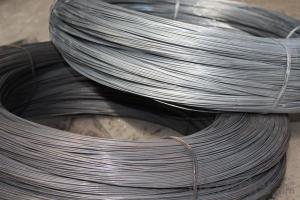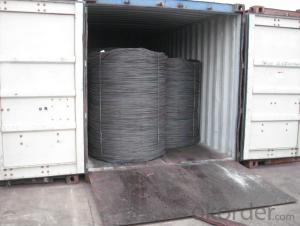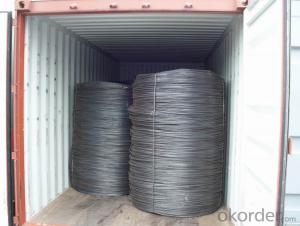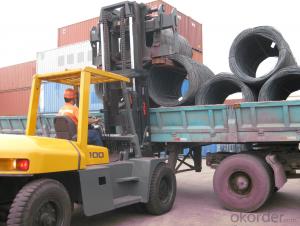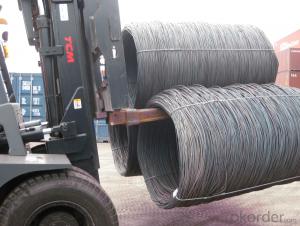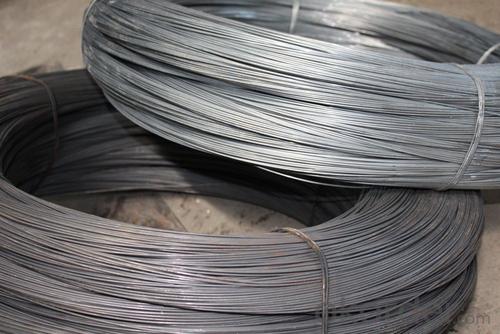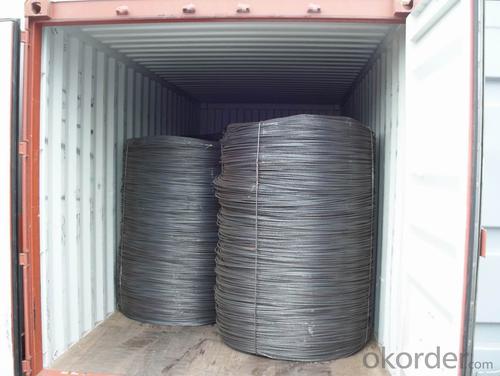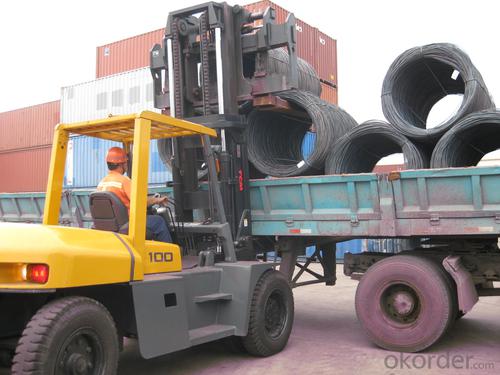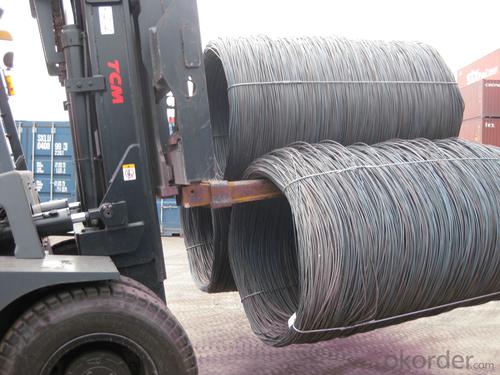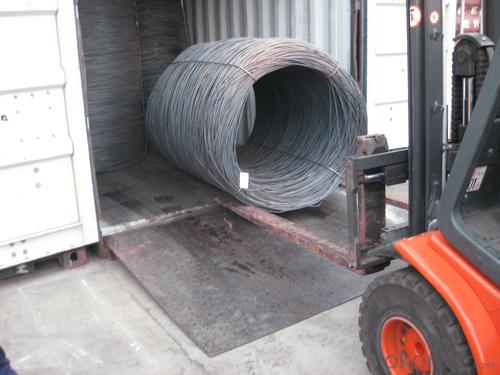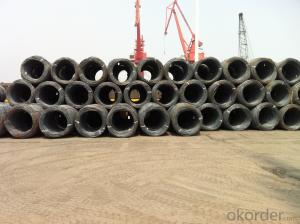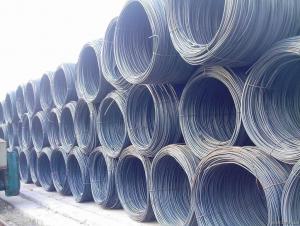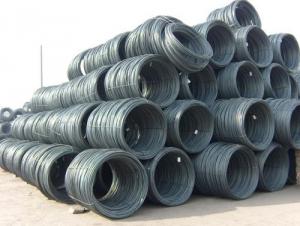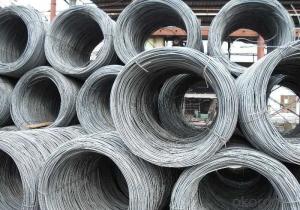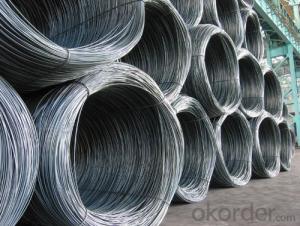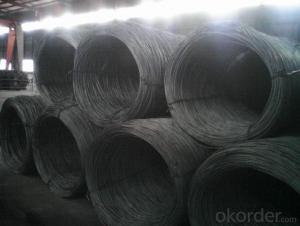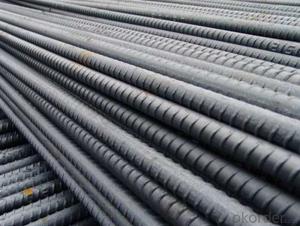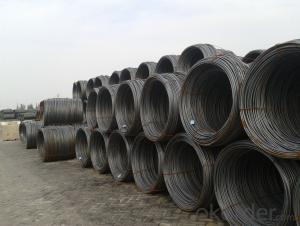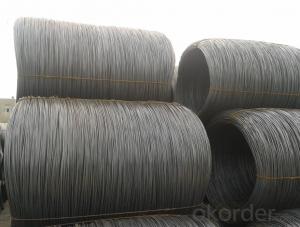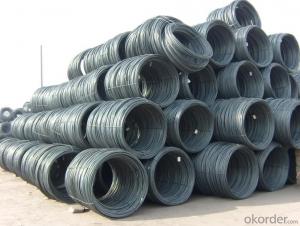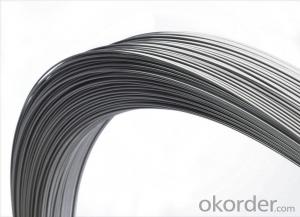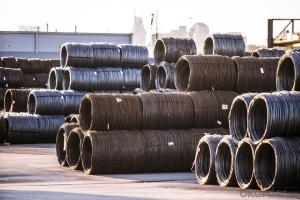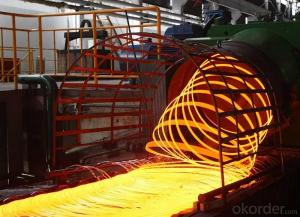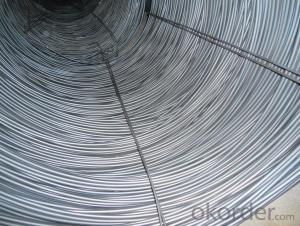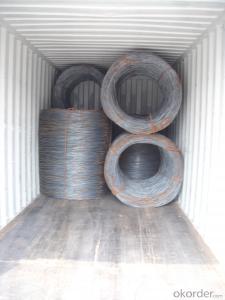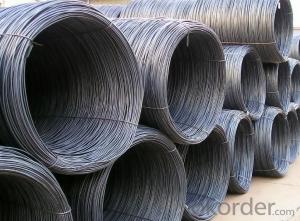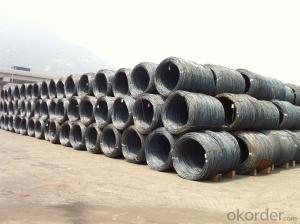SAE1006Cr Carbon Steel Wire Rod 11.5mm for Welding
- Loading Port:
- Shanghai
- Payment Terms:
- TT OR LC
- Min Order Qty:
- 100 m.t
- Supply Capability:
- 30000 m.t/month
OKorder Service Pledge
OKorder Financial Service
You Might Also Like
Specification
Description of SAE1006Cr Carbon Steel Wire Rod 11.5mm for Welding:
OKorder is offering Color Coated Steel Coil Prepainted Steel Coil at great prices with worldwide shipping. Our supplier is a world-class manufacturer of steel, with our products utilized the world over. OKorder annually supplies products to European, North American and Asian markets. We provide quotations within 24 hours of receiving an inquiry and guarantee competitive prices.
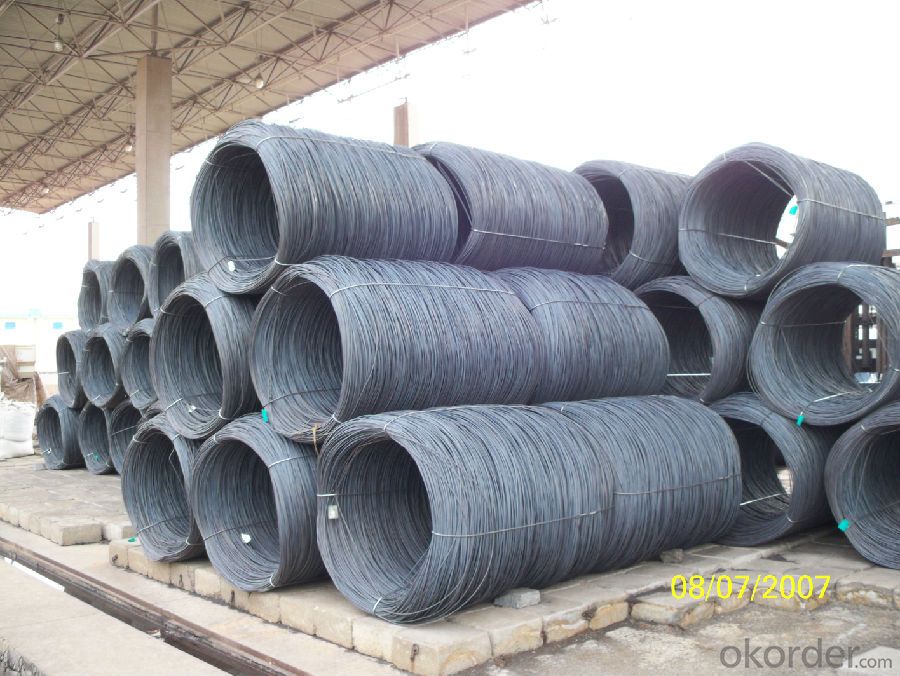
Applications of SAE1006Cr Carbon Steel Wire Rod 11.5mm for Welding:
Color Coated Steel Coil Prepainted Steel Coil are ideal for structural applications and are widely used in the construction of buildings and bridges, and the manufacturing, petrochemical, and transportation industries.
Main Product Features of SAE1006Cr Carbon Steel Wire Rod 11.5mm for Welding:
· Premium quality
· Prompt delivery & seaworthy packing (30 days after receiving deposit)
· Corrosion resistance
· Can be recycled and reused
· Mill test certification
· Professional Service
· Competitive pricing
Specifications of SAE1006Cr Carbon Steel Wire Rod 11.5mm for Welding:
PPGI:
1, Introduction: Color coated steel coils(sheets), i. E. PPGI, also called prepainted steel coils(sheets), are made of galvanized steel coils(sheets) with polymer coatings as surface. It's a new enclosure material and building board with characteristics of light-weighted, heat preserved&insulated, easily installed with bright colors.
2, Production Process: Pretreatment(Degreasing)_Drying_Chromating_Paint Basic Oil_Cooling_Drying_Color Coating_Cooling_Film-covering_Rolling Up
3, Characteristics:
Good at corrosion resistence. Besides zinc coating of the basic plate of galvanized steel sheet, the color coating as the surface has double lifetime to ensure better anticorrosion effect.
With excellent cold bending molded manufacturablity, PPGI products can be processed or directly used as final product. As being light-weighted and conveniently transported, they're widly used to replace wood to save energy.
4.There're thousands of colors can be chosen as per different application. Any color plays well in decoration.
No pollution with high recycling rate, PPGI coils and sheets are strongly recommended as enviroment-friendly products by the government.
5, eye bands and 4 circumferential bands in steel, galvanized metal fluted rings on inner and outer edges, galvanized.
| commodity | SAE1006Cr Carbon Steel Wire Rod 11.5mm for Welding |
| Techinical Standard: | JIS G3302-1998, EN10142/10137, ASTM A755 |
| grade | Q195,Q215,Q235,SAE1006,SAE1008 SAE1006Cr |
| Types: | Mesh welding |
| Base metal | galvanized, galvalume, cold rolled steel |
| Thickness | 0.14-1.0mm(0.16-0.8mm is the most advantage thickness) |
| Width | 610/724/820/914/1000/1200/1219/1220/1250mm |
| Type of coating: | PE, SMP, PVDF |
| Zinc coating | Z60-150g/m2 or AZ40-100g/m2 |
| Top painting: | 5 mic. Primer + 15 mc. R. M. P. |
| Back painting: | 5-7 mic. EP |
| Color: | According to RAL standard |
| ID coil | 508mm610mm |
| Coil weight: | 2--3MT |
| Package: | Properly packed for ocean freight exportation in 20'containers |
| Application: | Industrial panels, roofing and siding for painting/automobile |
| Price terms | FOB, CFR, CIF |
| Payment terms | 20%TT in advance+80% TT or irrevocable 80%L/C at sight |
| delivery time | 25 days after recepit of 20% TT |
| Remarks | Insurance is all risks |
| MTC 3.1 will be handed on with shipping documents | |
| We accept SGS certificatation test |
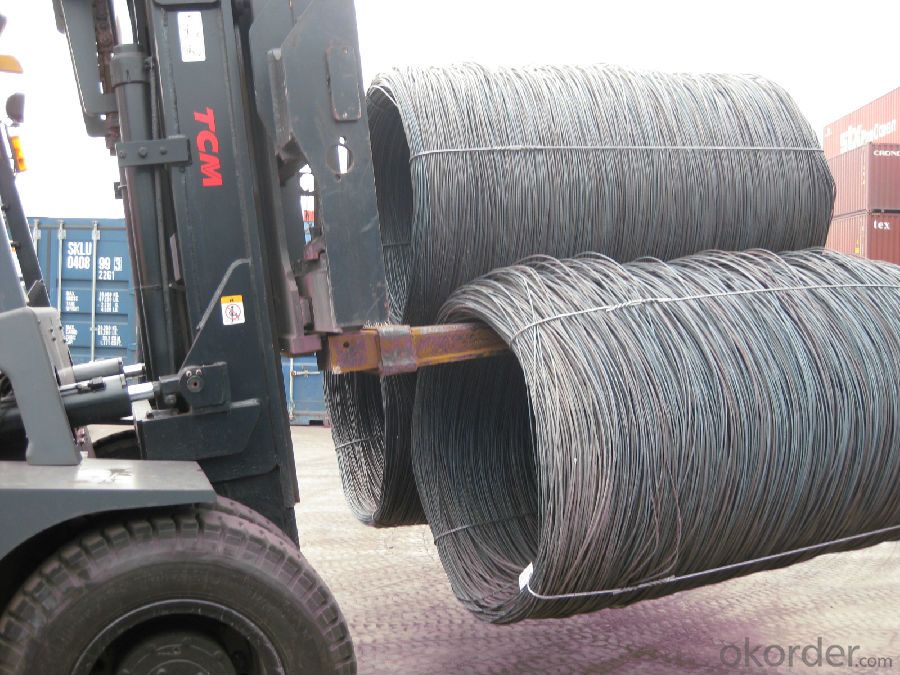
FAQ of SAE1006Cr Carbon Steel Wire Rod 11.5mm for Welding:
Q1: Why buy Materials & Equipment from OKorder.com?
A1: All products offered byOKorder.com are carefully selected from China's most reliable manufacturing enterprises. Through its ISO certifications, OKorder.com adheres to the highest standards and a commitment to supply chain safety and customer satisfaction.
Q2: How do we guarantee the quality of our products?
A2: We have established an advanced quality management system which conducts strict quality tests at every step, from raw materials to the final product. At the same time, we provide extensive follow-up service assurances as required.
Q3: How soon can we receive the product after purchase?
A3: Within three days of placing an order, we will begin production. The specific shipping date is dependent upon international and government factors, but is typically 7 to 10 workdays.
Q4: What makes stainless steel stainless?
A4: Stainless steel must contain at least 10.5 % chromium. It is this element that reacts with the oxygen in the air to form a complex chrome-oxide surface layer that is invisible but strong enough to prevent further oxygen from "staining" (rusting) the surface. Higher levels of chromium and the addition of other alloying elements such as nickel and molybdenum enhance this surface layer and improve the corrosion resistance of the stainless material.
Q5: Can stainless steel rust?
A5: Stainless does not "rust" as you think of regular steel rusting with a red oxide on the surface that flakes off. If you see red rust it is probably due to some iron particles that have contaminated the surface of the stainless steel and it is these iron particles that are rusting. Look at the source of the rusting and see if you can remove it from the surface.
- Q: How is steel wire rod used in the production of conveyor belts?
- Steel wire rod is an essential component in the manufacturing process of conveyor belts. It is widely used to reinforce and strengthen the structure of conveyor belts, ensuring their durability and reliability. To produce conveyor belts, steel wire rod is first drawn into thin, elongated wires through a series of mechanical processes, such as hot rolling, cold drawing, and annealing. These wires are then twisted and braided together to form a strong, flexible steel cord. The steel cord is embedded into the conveyor belt's core, providing excellent tensile strength and resistance to stretching. This reinforcement allows conveyor belts to carry heavy loads and endure high tension without breaking or deforming. Moreover, the steel cord also enhances the conveyor belt's resistance to impact, abrasion, and tearing. In addition to their structural benefits, steel wire rods used in conveyor belts offer other advantages. They have high thermal stability, ensuring that the conveyor belt can operate safely in extreme temperatures. Furthermore, the steel cord is highly resistant to corrosion, preventing premature deterioration of the conveyor belt. Overall, steel wire rod plays a crucial role in the production of conveyor belts by providing the necessary strength and durability required for their efficient operation. It ensures that conveyor belts can transport materials smoothly and reliably in various industries, such as mining, manufacturing, and logistics.
- Q: What are the different types of wire baskets and containers made from steel wire rod?
- There are several types of wire baskets and containers made from steel wire rod, including wire mesh baskets, wire storage bins, wire laundry hampers, and wire food storage containers. These baskets and containers are commonly used for storing and organizing various items in homes, offices, and industrial settings. They are known for their durability, lightweight design, and excellent ventilation properties.
- Q: How does the fatigue strength of steel wire rod vary with different heat treatment processes?
- The fatigue strength of steel wire rod can vary with different heat treatment processes. Heat treatment processes like annealing, quenching, and tempering can significantly affect the microstructure and mechanical properties of steel wire rod, including its fatigue strength. Annealing, for example, can help reduce internal stresses and improve the ductility of the wire rod, thus potentially increasing its fatigue strength. Quenching and tempering, on the other hand, can enhance the hardness and strength of the wire rod, but may also result in reduced ductility and potentially lower fatigue strength. Therefore, the specific heat treatment process used on steel wire rod can have a significant impact on its fatigue strength.
- Q: What are the different welding techniques used for steel wire rod?
- There are several welding techniques commonly used for steel wire rod, including arc welding, resistance welding, and laser welding. Arc welding involves using an electric arc to heat and melt the wire rod, creating a strong bond. Resistance welding uses electrical current and pressure to join the wire rod, while laser welding utilizes a concentrated beam of light to melt and fuse the metal together. Each technique has its advantages and is suitable for different applications and requirements in the steel wire rod industry.
- Q: How are steel wire rods used in the manufacturing of wire baskets?
- Steel wire rods are used in the manufacturing of wire baskets as the primary raw material. These rods are first processed and drawn into thinner wires, which are then woven or welded to form the basket's structure. The strength and durability of steel wire rods make them an ideal choice for creating sturdy and long-lasting wire baskets.
- Q: What are the different heat treatment options available for steel wire rod?
- Steel wire rod has a variety of heat treatment options available, each with its own unique properties and characteristics. Some commonly used methods for heat treating steel wire rod include: 1. Annealing: This involves heating the wire rod to a specific temperature and then slowly cooling it down. Annealing helps to relieve internal stresses, improve machinability, and enhance the ductility and toughness of the wire rod. 2. Normalizing: In this method, the wire rod is heated above its critical point and then cooled in still air. Normalizing helps refine the grain structure, improve mechanical properties, and enhance overall strength and hardness. 3. Quenching and tempering: This two-step process starts by heating the wire rod to a high temperature and then rapidly cooling it in a quenching medium such as water or oil. Quenching achieves a high hardness, while tempering involves reheating and then slowly cooling the wire rod. This process reduces brittleness and increases toughness and ductility. 4. Case hardening: Also known as carburizing, this method introduces carbon into the surface layer of the wire rod by heating it in a carbon-rich atmosphere. Case hardening provides a hard and wear-resistant outer layer while maintaining a tough and ductile core. 5. Stress relieving: This option is used to reduce residual stresses that may have developed during manufacturing processes like cold working or machining. The wire rod is heated below the critical point and then cooled slowly. Stress relieving improves dimensional stability and reduces the risk of distortion or cracking. These heat treatment options can be combined or used individually depending on the desired properties and applications of the wire rod. Factors such as steel composition, desired hardness, strength, and other mechanical properties should be considered when choosing the appropriate heat treatment method.
- Q: What are the main factors influencing the choice of steel wire rod order customer feedback process?
- Several key considerations can influence the choice of the customer feedback process for steel wire rod orders. The quality of the steel wire rod is a primary determining factor. If the product is of high quality and meets the customer's expectations, the feedback process is likely to be straightforward and positive. Conversely, if there are quality issues such as defects or inconsistencies, the feedback process may become more complex and require in-depth analysis. Another factor is the level of customer satisfaction with the overall buying experience. This encompasses factors like the ordering process's ease, the timeliness of delivery, and the level of customer service provided. A positive buying experience increases the likelihood of customers providing feedback and sharing their thoughts on the product. The supplier's reputation and track record also impact the customer feedback process. If the supplier has a history of delivering high-quality products and excellent customer service, customers are more inclined to give positive feedback. However, a supplier with a poor reputation or a track record of subpar products may receive negative feedback or no feedback at all. The importance of the steel wire rod to the customer's business is another consideration. If the rod is a critical component of the customer's operations, they are more likely to provide feedback and express any concerns or issues. Conversely, if the rod is not crucial, the customer may be less motivated to provide feedback. In conclusion, the choice of the customer feedback process for steel wire rod orders is influenced by factors such as product quality, customer satisfaction with the buying experience, supplier reputation, and the rod's importance to the customer's business. By considering these factors, suppliers can customize their feedback processes to effectively address customer concerns and improve satisfaction.
- Q: How is steel wire rod used in the manufacturing of wire connectors?
- Steel wire rod is used in the manufacturing of wire connectors as it serves as the raw material. The wire rod is processed and shaped to form the conductive components of the connectors, ensuring a secure and reliable electrical connection.
- Q: How is steel wire rod used in the production of wire mesh for animal enclosures?
- Steel wire rod is an essential element in manufacturing wire mesh for animal enclosures, as it serves as the primary material from which the wire mesh is formed. The wire rod, typically composed of low carbon steel, undergoes a series of processes to achieve the desired wire mesh. To begin, the steel wire rod is drawn through a set of dies to reduce its diameter and increase its length. This wire drawing process ensures that the wire rod possesses the appropriate thickness and strength required for its intended use in animal enclosures. Once the wire has been drawn, it is often galvanized to enhance its durability and resistance to corrosion. Galvanization entails immersing the wire in molten zinc, resulting in a protective zinc coating that effectively prevents rust and prolongs the lifespan of the wire mesh. Subsequently, the galvanized wire is either woven or welded together to form the wire mesh structure. Woven wire mesh is created by interlocking the wires in a crisscross pattern, resulting in a robust and flexible mesh. Conversely, welded wire mesh is fashioned by joining the wires together at their intersections, yielding a more rigid and stable mesh. The wire mesh produced from steel wire rod offers several benefits for animal enclosures. Its strength and durability enable it to withstand the impact and pressure exerted by animals, ensuring their safe containment. Additionally, the small gaps between the wires provide ventilation and visibility, allowing animals to see their surroundings while maintaining a secure enclosure. In conclusion, steel wire rod plays a crucial role in the production of wire mesh for animal enclosures, providing the necessary strength, durability, and security to create a safe and reliable enclosure for various types of animals.
- Q: How is steel wire rod classified based on its surface condition?
- Steel wire rod can be categorized into three main groups based on its surface condition. The first category is bright or untreated surface, which refers to wire rod that has not undergone any surface treatment or coating. This type of wire rod has a clean and smooth surface, without any contaminants or oxidation. It is commonly used in applications that require a clean appearance or high conductivity, such as electrical wire manufacturing, cable production, and spring production. The second category is coated or galvanized surface, which involves treating the wire rod with a protective layer, usually through galvanization or zinc coating. This protective coating enhances the wire rod's resistance to corrosion by acting as a barrier against moisture and other corrosive elements. It makes the wire rod suitable for outdoor applications or environments with high humidity or exposure to chemicals. Industries like construction, fencing, and automotive often use coated steel wire rod. The third category is coated and drawn surface, which refers to wire rod that has undergone both a coating and a drawing process. The coating is applied to the wire rod before it is drawn through a series of dies, reducing its diameter and increasing its tensile strength. This process results in a smooth and uniform surface with improved mechanical properties. Coated and drawn steel wire rod is commonly used in applications that require high-strength wire, such as wire ropes, tire reinforcement, and suspension springs. In conclusion, classifying steel wire rod based on its surface condition aids in determining its suitability for various applications, considering factors like corrosion resistance, conductivity, appearance, and mechanical properties.
Send your message to us
SAE1006Cr Carbon Steel Wire Rod 11.5mm for Welding
- Loading Port:
- Shanghai
- Payment Terms:
- TT OR LC
- Min Order Qty:
- 100 m.t
- Supply Capability:
- 30000 m.t/month
OKorder Service Pledge
OKorder Financial Service
Similar products
Hot products
Hot Searches
Related keywords
